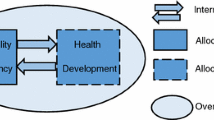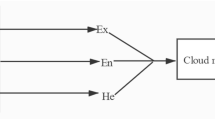Abstract
The evaluation of water quality is challenging because it is involved with various uncertainty factors. A connection cloud model coupled with extenics, taking into account of randomness, fuzziness and incompatibility of evaluation indicators, was presented here to analyze the water quality. First, according to the classification standard, left and right half interval lengths of evaluation indicator were specified to assign the digital features of the connection cloud at various levels. Then, a matter element was built with the connection cloud model. Namely, connection clouds in finite intervals were simulated to analyze the certainty degree of measured indicator to each evaluation standard, the certainty degree of indicator was calculated, and the extension matrix was constructed based on connection cloud. Next, associated with the weight vector of indicators, the integrated certainty degree was calculated to determine the class of water quality. Finally, a case study and comparisons with other methods were performed to confirm the validity and reliability of the proposed model. The results show that this model can not only quantitatively describe certainty and uncertainty relationship between evaluation indicators and classification standard in a unified way, but also make the evaluation result more reasonable.




Similar content being viewed by others
References
Cai W (1994) Matter-element model and its application. Science Press, Beijing, China (in Chinese)
Carpenter SR, Ludwig D, Brock WA (1999) Management of eutrophication for lakes subject to potentially irreversible change. Ecol Appl 9(3):751–771
Chen LL, Jin LH (2014) An improved fuzzy comprehensive evaluation method of eutrophication for lakes and reservoirs. China Environ Sci 34(12):3223–3229 (in Chinese)
Conley DJ, Paerl HW, Howarth RW, Boesch DF, Seitzinger SP, Havens KE, Lancelot C, Likens GE (2009) Controlling eutrophication: nitrogen and phosphorus. Science 323(5917):1014–1015
Cui DW (2006) The application of MATLAB neural network in the evaluation of eutrophication of lake reservoir. Environmental Research and Monitoring 26:42–48
Cui DW (2012) Applications of several neural network models to eutrophication evaluation of lakes and reservoirs. Water Resources Protection 25(5):12–18
Dodds WK, Bouska WW, Eitzmann JL, Pilger TJ, Pitts KL, Riley AJ, Schloesser JT, Thornbrugh DJ (2009) Eutrophication of U.S. freshwaters: analysis of potential economic damages. Environmental Science & Technology 43(1):12–19
Elżbieta JR, Piotr Z, Grabowska M, Jolanta EK, Maciej K, Adam W (2014) The trophic status of Suwałki Landscape Park lakes based on selected parameters (NE Poland). Environmental Monitoring & Assessment 186(8):5101–5121
Feng CH (2004) Research on eutrophication assessment predication of lakes and reservoirs. Xi'an University of Technology (in Chinese)
Fernández JRA, Nieto PJG, Muñiz CD, Antón JCÁ (2014) Modeling eutrophication and risk prevention in a reservoir in the northwest of Spain by using multivariate adaptive regression splines analysis. Ecol Eng 68:80–89
Ferreira JG, Andersen JH, Borja A, Bricker SB, Camp J, Silva MCD et al (2011) Overview of eutrophication indicators to assess environmental status within the European marine strategy framework directive. Estuarine Coastal & Shelf Science 93(2):117–131
Gazzaz NM, Yusoff MK, Aris AZ, Juahir H, Ramli MF (2012) Artificial neural network modeling of the water quality index for Kinta River (Malaysia) using water quality variables as predictors. Mar Pollut Bull 64(11):2409–2420
Hu LH, Pan A, Li TS, Li CZ, Wang YH (2008) Application of the grey clustering method to assessing the eutrophication of Shengzhong reservoir. Journal of Agro-Environment Science 27(6):2407–2412 (in Chinese)
Kitsiou D, Karydis M (2011) Coastal marine eutrophication assessment: a review on data analysis. Environ Int 37(4):778–801
Li DY (2005) Artificial intelligence with uncertainty. National Defence Industry Press, Beijing, China (in Chinese)
Li P, Li X, Meng X, Li M, Zhang Y (2016) Appraising groundwater quality and health risks from contamination in a semiarid region of Northwest China. Expo Health 8(3):361–379. https://doi.org/10.1007/s12403-016-0205-y
Li P, Feng W, Xue C, Tian R, Wang S (2017) Spatiotemporal variability of contaminants in Lake water and their risks to human health: a case study of the Shahu lake tourist area, Northwest China. Expo Health 9(3):213–225. https://doi.org/10.1007/s12403-016-0237-3
Li P, He S, He X, Tian R (2018) Seasonal hydrochemical characterization and groundwater quality delineation based on matter element extension analysis in a paper wastewater irrigation area, Northwest China. Expo Health 10(4):241–258. https://doi.org/10.1007/s12403-17-0258-6
Newton A, Icely JD, Falcao M, Nobre A, Nunes JP, Ferreira JG, Vale C (2003) Evaluation of eutrophication in the Ria Formosa coastal lagoon, Portugal. Cont Shelf Res 23(17):1945–1961
Parinet B, Lhote A, Legube B (2004) Principal component analysis: an appropriate tool for water quality evaluation and management-application to a tropical lake system. Ecol Model 178(3–4):295–311
Shu J (1990) The assessment methodology for eutrophication level of lakes in China. Environmental Pollution & Control l12(5): 2–7 (in Chinese)
Shu J (1993) Assessment of eutrophication in main lakes of China. Oceanologia Et Limnologia Sinica 117(5):920–928 (in Chinese)
Smith VH, Tilman GD, Nekola JC (1999) Eutrophication: impacts of excess nutrient inputs on freshwater, marine, and terrestrial ecosystems. Environ Pollut 100(1):179–196
Strobl RO, Forte F, Pennetta L (2007) Application of artificial neural networks for classifying lake eutrophication status. Lakes Reserv Res Manag 12(1):15–25
Taner MÜ, Üstün B, Erdinçler A (2011) A simple tool for the assessment of water quality in polluted lagoon systems: a case study for Küçükçekmece lagoon, Turkey. Ecol Indic 11(2):749–756
Wang MW, Jin JL (2017) The theory and applications of connection numbers. Science Press, Beijing, China (in Chinese)
Wang GZ, Ren LL, Wang B, Yu ZB (2009) Lake eutrophication evaluation model based on projection pursuit method. Water Resources Protection 25(5):14–18 (in Chinese)
Wang MW, Jin JL, Zhou YL (2014) Set pair analysis based coupling methods and applications. Science Press, Beijing, China (in Chinese)
Wang M, Xu X, Li J, Jin J, Shen F (2015) A novel model of set pair analysis coupled with extenics for evaluation of surrounding rock stability. Math Probl Eng:1): 1–1): 9
Wang D, Liu D, Ding H, Singh VP, Wang Y, Zeng X, Wu J, Wang L (2016a) A cloud model-based approach for water quality assessment. Environ Res 148:24–35
Wang D, Zeng D, Singh VP, Xu P, Liu D, Wang Y, Zeng X, Wu J, Wang L (2016b) A multidimension cloud model-based approach for water quality assessment. Environ Res 149(1):113–121
Wang M, Wang X, Liu Q, Shen F, Jin J (2020) A novel multi-dimensional cloud model coupled with connection numbers theory for evaluation of slope stability. Appl Math Model 77:426–538. https://doi.org/10.1016/j.apm.2019.07.043
Wu J, Xue C, Tian R, Wang S (2017) Lake water quality assessment: a case study of Shahu Lake in the semi-arid loess area of Northwest China. Environ Earth Sci 76:232. https://doi.org/10.1007/s12665-017-6516-x
Yan H, Huang Y, Wang G, Zhang X, Shang M, Feng L, Dong J, Shan K, Wu D, Zhou B, Yuan Y (2016) Water eutrophication evaluation based on rough set and petri nets: a case study in Xiangxi-River, three gorges reservoir. Ecol Indic 69:463–472
Yu J, Wang Z, Wang X, Xu J, Jia J (2017) Study on mechanism experiments and evaluation methods for water eutrophication. Journal of Chemistry 6:1–7 (in Chinese)
Zheng G, Jing Y, Huang H, Zhang X, Gao Y (2014) Application of life cycle assessment (LCA) and extenics theory for building energy conservation assessment. Energy 34(11):1870–1879
Zou ZH, Yun Y, Sun JN (2006) Entropy method for determination of weight of evaluating indicators in fuzzy synthetic evaluation for water quality assessment. J Environ Sci 18(5):1020–1023
Acknowledgements
Financial support provided by the National Key Research and Development Program of China under Grant No. 2016YFC0401303 and 2017YFC1502405 and the National Natural Sciences Foundation, China (No. 51579059 and 41172274) is gratefully acknowledged. The author would also like to express sincere thanks to the reviewers for their thorough reviews and useful suggestions.
No conflict of interest exists in the submission of this manuscript, and manuscript is approved by all authors for publication.
Author information
Authors and Affiliations
Corresponding author
Additional information
Communicated by: H. Babaie
Publisher’s note
Springer Nature remains neutral with regard to jurisdictional claims in published maps and institutional affiliations.
Rights and permissions
About this article
Cite this article
Liu, Q., Wang, M., Zhou, T. et al. A connection cloud model coupled with extenics for water eutrophication evaluation. Earth Sci Inform 12, 659–669 (2019). https://doi.org/10.1007/s12145-019-00403-1
Received:
Accepted:
Published:
Issue Date:
DOI: https://doi.org/10.1007/s12145-019-00403-1




